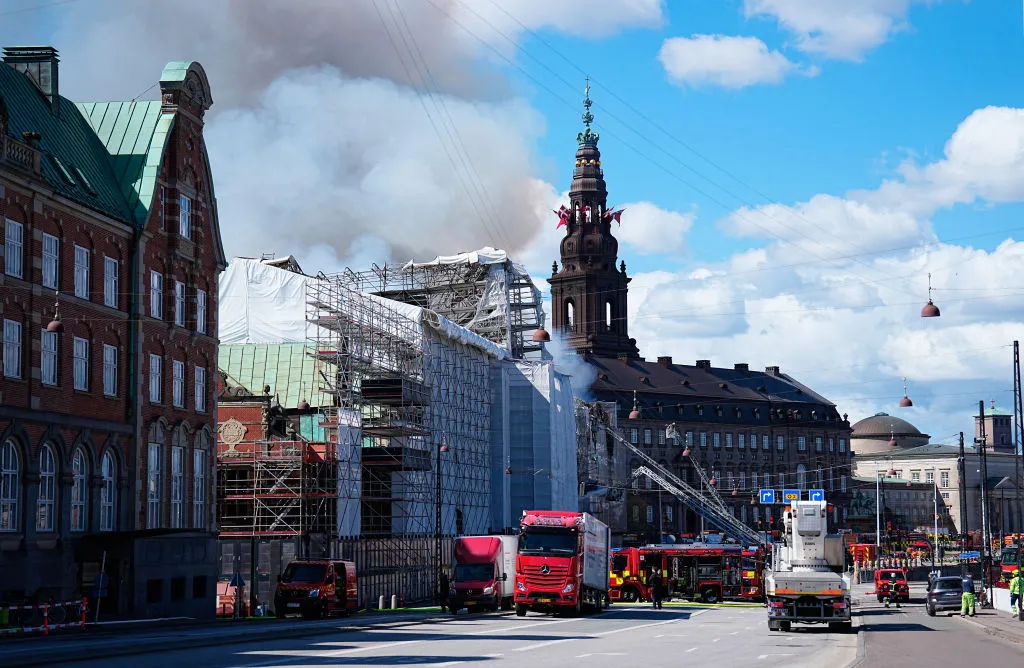
To receive Morning Links in your inbox every weekday, sign up for our Breakfast with ARTnews newsletter.
THE HEADLINES
ISRAELI PAVILION SHUT. The Israeli artist and curators chosen to represent their country at the Venice Biennale have refused to open their national pavilion exhibit, titled “(M)otherland”, until there is “a ceasefire and hostage release agreement.” In the early hours of a press opening today, the doors remained shut to the exhibit installed with artworks by Ruth Patir, which address the pressures on women to become mothers. Outside the pavilion entrance, a much-Instagrammed, taped sign read: “The artist and curators of the Israeli pavilion will open the exhibition when a ceasefire and hostage release agreement is reached.” Speaking to the New York Times, Patir admitted: “I hate it, but I think it’s important.” Earlier this year, pro-Palestinian activists had called for a ban on Israel’s participation in the Biennale, but organizers vehemently dismissed those demands. Patir also said she hoped there would be a ceasefire and hostage release before the show closes on November 24, so that the public could see the artworks inside. “I believe we will open it,” Patir said. “I believe we will.”
FIRE FIGHTING. Copenhagen’s 400-year-old, iconic stock exchange building has caught fire, and early images show rescuers and passersby hurriedly trying to save art treasures as the monument’s spire burned, and then collapsed. “Our own Notre Dame moment,” said Denmark’s deputy prime minister, Troels Lund Poulsen in a social media post. As of this morning, there were no reports of injuries, with everyone inside able to leave in time. The 1625-building, which houses the chamber of commerce, and is full of paintings by 17th century Danish artists, was under renovation when the fire broke, and can be seen covered in scaffolding. Emergency services also told reporters the scaffolding made it more difficult to put out the fire.
THE DIGEST
The Center for Native Futures is raising concerns over the ethics of selling and exhibiting historic ledger drawings by imprisoned Native Americans at the most recent Expo Chicago. “I was surprised to see ledger art outside of a tribal cultural center, museum or archive and also available for purchase,” said Casey Brown (Ho-Chunk), an artist and member of the Center. “This art was made under duress while these men were unjustly imprisoned; ownership of any of these works is problematic.” [Hyperallergic]
The Hudson Yard’s 150-foot-tall, beehive-like Vessel sculpture will reopen this year, following a series of suicides committed from the art piece that opened in 2019. Many of the landings and staircases on the structure will now be covered with a protective “floor-to-ceiling steel mesh” as a precaution. [The New York Times]
In recent months there has been a rise in thefts of bronze and copper sculptures and plaques in the Los Angeles area, which can be valuable when melted down, recast and sold. In the latest case earlier this month, a newsboy was removed from a sculpture of the military officer and owner of the publication which preceded the Los Angeles Times, Harrison Gray Otis, located in MacArthur Park. Paul Troubetzkoy made the sculpture over 100 years ago, and his work will be the subject of a forthcoming exhibit at the Musée d’Orsay in Paris. [The Los Angeles Times]
The flame for the 2024 Paris Olympics was lit today in a choreographed dance and performance in Olympia, Greece, by actresses dressed as ancient priestesses. Held where the earliest recorded games took place in 776 BCE, the flame will now be relayed on its journey to Paris. [CNN]
Did the United States rig a Golden Lion Win with Robert Rauschenberg’s 1964 victory? A new documentary revisits the historic Venice Biennale scandal in a documentary called Taking Venice, by Amei Wallach, which connects the commissioner, the insider, the dealer, and the artist into a web that takes cues from the spy genre. [ARTnews]
Ushio Amagatsu, the Japanese Butoh dancer whose real name was Masakazu Ueshima, has died at age 74 of heart failure, following a battle with hypopharynx cancer. Amagatsu brought worldwide recognition to the minimalist performance art form which is derived from the Japanes “ankoku buto,” meaning “dance of darkness.” [The Japan News]
Protestors from environmental groups occupied London’s Science Museum over the weekend and were joined by broadcaster and environmental activist Chris Packham. Some 30 individuals took over the museum’s new climate-themed gallery, Energy Revolution, in the latest action against the museum’s sponsorship by the coal-producing conglomerate Adani. [The Standard]
THE KICKER
NO IDLING IN VENICE. When in Venice “it is essential not to stroll or idle or appear leisurely or slack,” writes author Colm Tóibíin in a poetic, fast-read for Frieze Magazine that’s sorely needed amid the onslaught of news and art jargon-filled criticism. An astute observer, Tóibíin describes spending time in Venice as a writer, artist, and/or someone interested in both. “In the city, it is necessary to battle against the vice of sauntering, idly ambling. In Venice, as in life, it is necessary to have a clear aim, no time for dreaming or deviation,” he writes. Tóibíin elaborates onto how Henry James experienced the town, tracking down the room where he wrote, and admitting to feeling underwhelmed by it. So how does one properly follow Tóibíin’s sound advice when in the Italian lagoon city? He says to either pick three great paintings and visit them every day – so that you know your route by heart — or choose three “lesser-known paintings that hang in places that are harder to find or in churches that are often locked.” And basta.

